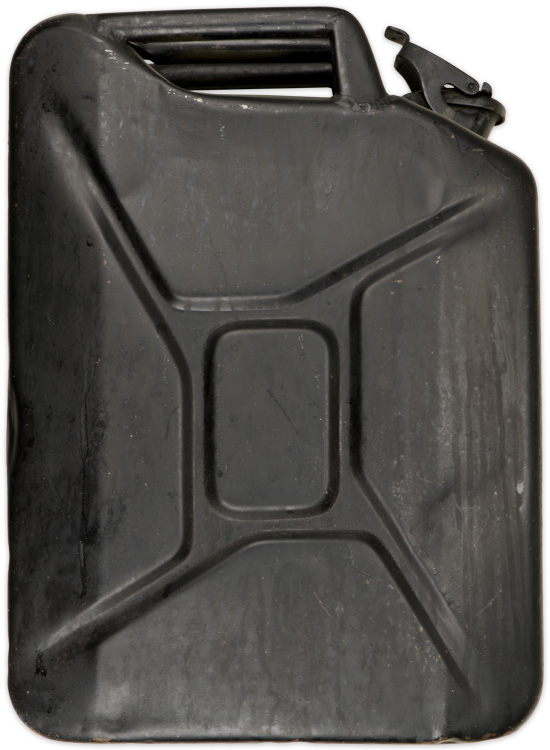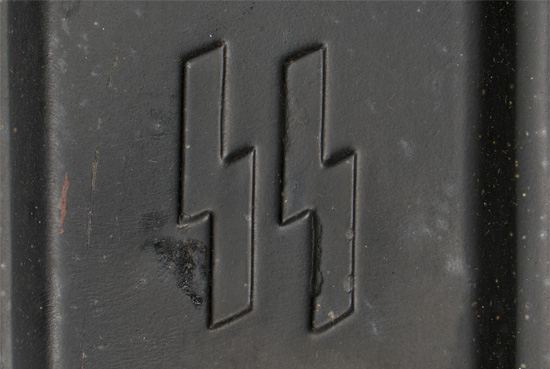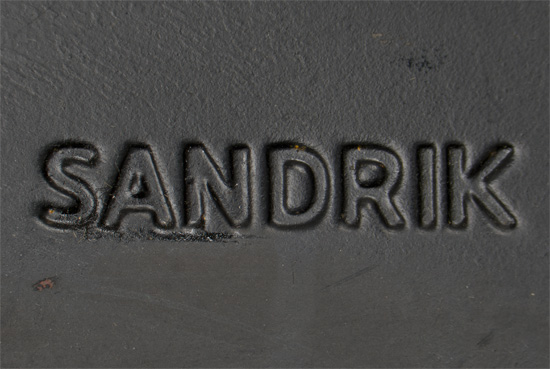







S001494 TWENTY LITER CAPACITY, "JERRY" GASOLINE CAN. (Kraftstoff Kanne)
BACKGROUND: Although the German armed forces of WWII still utilized a large quantity of horses the standard infantry division, prior to 1943, would have contained roughly nine hundred assorted gasoline powered vehicles and consumed an average of twenty tons of gasoline per day. Motorized, mechanized and armored divisions with considerably more gasoline powered vehicles would have expended enormous amounts of fuel in daily operations. For example a single Pz.Kpfw. IV, (Tiger I), tank, with a fuel capacity of five hundred thirty-four liters, would consume roughly all of its fuel traveling at an average speed of twenty kilometers per hour, for ever one hundred kilometers of road travel or about half that distance on normal cross country terrain. Therefore it would require approximately twenty-seven full, twenty liter capacity gasoline cans for a single Pz.Kpfw. IV, (Tiger I), tank to cover one hundred kilometers of road travel. This enormous fuel consumption required continual resupply. Of Note: Supply for the Waffen-SS was under the control of the SS-FHA, SS-Führungshauptamt, (SS-Operational Headquarters), and the SS-WVHA, SS-Wirtschafts und Verwaltungs Hauptamt, (SS-Economic and Administration Department). The SS-FHA was responsible for issuing the initial equipment, supply and maintenance of weapons and ammunition, and the supply of technical equipment and transport vehicles. The SS-WVHA, was responsible for issue of clothing and personal equipment items as well as rations including horse and pack animal fodder and fuel allocations. Also Of Note: The classic "Jerry" can design was originally adopted by the German armed forces in late 1936 or early 1937 and was so successful that the allies valued captured cans and based their own on the same design. After the successful occupation of Czechoslovakia in March 1939 the German armed forces soon began utilizing all forms of Czech industry to make up for short falls in German production. The Czechoslovakian Sandrik firm began producing the "Jerry" cans for the Germans and is believed most, if not all, of the "Jerry" cans utilized by the SS were manufactured by this firm.
PHYSICAL DESCRIPTION: Roughly, 47cm tall, 35cm wide and 14cm deep, magnetic sheet metal construction gasoline can with three, horizontal, welded, tubular handles and a raised, pour spout to the top edge. The top edge has dual, downward diagonally angled, "steps", resulting in the pouring spout being positioned lower then the carrying handles. Each side of the can has a large, impressed, strength reinforcing and gas expansion, stylized "X". The can was constructed of two halves and has a central, recessed, vertical, seam with a raised, welded bead. The pouring spout has a hinged cap with dual, extended, locking arms which slide into two, raised, welded, retaining loops. The interior pouring spout rubber seal is still intact. The top interior of the pouring spout has the addition of a hollow, air access tube to facilitate ease of pouring. The can has deeply stamped script to one side which includes, "Kraftstoff 20l Feuergefährlich", (Fuel 20 liters, Highly Combustible), and the SS runes. The can also has the stamped manufacturer’s name, "Sandrik". Shows the expected age, period use and wear. The can is in overall good condition with a couple of small dings and dents and has been over-painted in black.
GRADE
****
PRICE $ ![]()
To Order this item, please use one of the two e-mail addresses below to contact us. Please make sure to quote the item number in your e-mail
MILITARIA WANTED! If you have items for sale, please contact us. We specialize in selling single pieces and entire collections. Over 3 decades in the business and we do all the work for you. Get the best return for your investment.
-E-Mail Address pawmac@nbnet.nb.ca Or guild@nb.aibn.com
To return to the main page please CLICK below